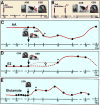Differential control of appetitive and consummatory sexual behavior by neuroestrogens in male quail
- PMID: 29452074
- PMCID: PMC6103895
- DOI: 10.1016/j.yhbeh.2018.02.006
Differential control of appetitive and consummatory sexual behavior by neuroestrogens in male quail
Abstract
Contribution to Special Issue on Fast effects of steroids. Estrogens exert pleiotropic effects on multiple physiological and behavioral traits including sexual behavior. These effects are classically mediated via binding to nuclear receptors and subsequent regulation of target gene transcription. Estrogens also affect neuronal activity and cell-signaling pathways via faster, membrane-initiated events. Although the distinction between appetitive and consummatory aspects of sexual behavior has been criticized, this distinction remains valuable in that it facilitates the causal analysis of certain behavioral systems. Effects of neuroestrogens produced by neuronal aromatization of testosterone on copulatory performance (consummatory aspect) and on sexual motivation (appetitive aspect) are described in male quail. The central administration of estradiol rapidly increases expression of sexual motivation, as assessed by two measures of sexual motivation produced in response to the visual presentation of a female but not sexual performance in male Japanese quail. This effect is mimicked by membrane-impermeable analogs of estradiol, indicating that it is initiated at the cell membrane. Conversely, blocking the action of estrogens or their synthesis by a single intracerebroventricular injection of estrogen receptor antagonists or aromatase inhibitors, respectively, decreases sexual motivation within minutes without affecting performance. The same steroid has thus evolved complementary mechanisms to regulate different behavioral components (motivation vs. performance) in distinct temporal domains (long- vs. short-term) so that diverse reproductive activities can be properly coordinated. Changes in preoptic aromatase activity and estradiol as well as glutamate concentrations are observed during or immediately after copulation. The interaction between these neuroendocrine/neurochemical changes and their functional significance is discussed.
Keywords: Dual action of estrogens; Membrane estrogen receptors; Membrane-initiated effects; Preoptic aromatase; Sexual motivation; Testosterone.
Copyright © 2018 Elsevier Inc. All rights reserved.
Figures





References
-
- Absil P, Baillien M, Ball GF, Carlo Panzica G, Balthazart J. The control of preoptic aromatase activity by afferent inputs in Japanese quail. Brain Research Reviews. 2001a;37:38–58. - PubMed
-
- Absil P, Das S, Balthazart J. Effects of apomorphine on sexual behavior in male quail. Pharmacol Biochem Behav. 1994;47:77–88. - PubMed
-
- Absil P, Riters LV, Balthazart J. Preoptic aromatase cells project to the mesencephalic central gray in the male Japanese quail (Coturnix japonica) Hormones and Behavior. 2001b;40:369–383. - PubMed
-
- Adkins EK. Hormonal basis of sexual differentiation in the Japanese quail. J Comp Physiol Psychol. 1975;89:61–71. - PubMed
-
- Adkins EK. Effects of diverse androgens on the sexual behavior and morphology of castrated male quail. Horm Behav. 1977;8:201–207. - PubMed
Publication types
MeSH terms
Substances
Grants and funding
LinkOut - more resources
Full Text Sources
Other Literature Sources

